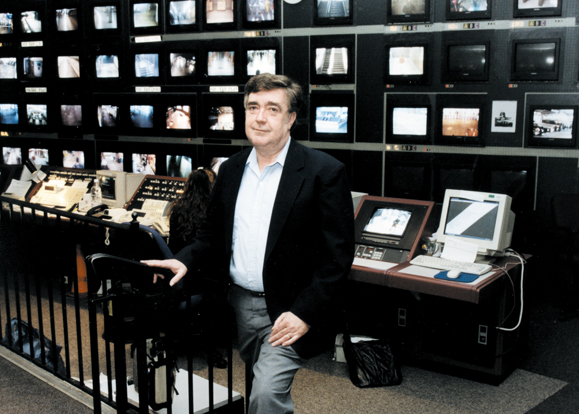The PATH (Port Authority Trans Hudson) railroad normally discharged up to 5,000 passengers in the period between 8:47 a.m. and 9:15 a.m. at its World Trade Center station. However, shortly after the first plane flew into the North Tower, quick-thinking and fast responses from the PATH personnel ensured the safe evacuation of thousands of passengers from the WTC area. Ritchie Moran, a PATH trainmaster with 20 years experience, played an important role in this critical and well-coordinated rescue mission. At approximately 8:46 on the morning of September 11th, he was carrying out his usual duties as PATH trainmaster in the Journal Square Transportation Center in Jersey City when he received the first of many calls telling him that a plane had hit the World Trade Center.
At 8:51, 12 minutes before the second plane hit the second tower, Moran had received a call from Victoria Cross-Kelly, PATH’s Deputy Director who was at a conference in the WTC, telling him not to discharge any more passengers at the WTC station. “There was one train already discharging passengers in the station. The crew were instructed to put the passengers back on the train. It was very confusing as we were having a major problem trying to get control of the radio and telephones, people were calling to let us know what was going on and tying up the lines. We already knew but still had to take every call in case it was an instruction.” Moran pays tribute to his colleagues who were at the station on the day. “The crews were terrific — even with the problems we were having communicating with them, they took it upon themselves to get passengers back onto the train and out of the station.”
Three more trains holding up to a thousand passengers each were rerouted away from the station and back to Exchange Place in the period between Ms. Kelly’s phone call and the second impact. Moran explains that after the second tower was struck, a train was sent to the WTC with an engineer and a conductor to pick up remaining passengers and personnel. “A rescue train was instructed to leave Exchange Place in Jersey and arrived at the WTC at 9:10. It left the WTC at 9:12 — it was the last train to leave. For that train, two Port Authority police officers, one of whom later died, went up to the concourse level — the shopping level — and brought some people down. That rescue train was important; it even got a homeless guy who was on the platform (and who took a lot of coaxing to get onto the train) to safety.”
What was remarkable about the evacuation of the PATH station was how quickly the PATH Railroad and Port Authority officers reacted to the emergency situation. To put it in context, New York airports were not shut down until 9:17 and flight operations at all U.S. airports were not stopped until 9:40. Amidst all the confusion and madness of those first 20 minutes, the Port Authority was able to make unprecedented decisions and put emergency procedures into practice.
Moran feels that to some extent, the Port Authority and PATH operators benefited from experience gained in the 1993 bombing attack in which six people died. “After the 1993 bombing, the Port Authority police at the WTC were more attuned to the possibility of terrorist attacks. They acted really quickly. Some officers who were in New Jersey got upstairs and in position at the WTC within 5-6 minutes of the first call.”
Moran is anxious to point out that it took concerted team effort to get people out. “We were very fortunate — we got a lot of cooperation. The Port Authority were very quick to react, but even the passengers were cooperative. We were afraid that some of them might pull the emergency stop handle when they saw their trains weren’t stopping where they should, but nobody did. We had another problem in that we started to lose power. There would have been a problem getting trains back to New Jersey from the tunnel if we had lost power, but no trains got stuck. At Exchange Place, we had personnel who evacuated people from there. You could see everything that was happening across the river. We had trains bring people away from Exchange Place and were able to maintain service until 10:20 a.m.”
Nearly six months after the tragedy, Moran and other PATH personnel are still experiencing disruption and loss in their working life. “On one level, things are getting back to normal, and on another, things will never be the same again. We lost five percent of our railroad and are still changing our train service to accommodate recovery work and changing passenger habits due to the relocation of workers. Here at work, the Port Authority is like a small family — we knew 13 of the Port Authority officers who died very well.”
At least Moran has the comfort of knowing that he was part of a team that contributed to saving thousands of lives on that terrible day. “It’s a good feeling. That whole week was very difficult for us. We were very busy at work, trying to set up a new service, and it wasn’t until later that I had time to reflect on it. We got a lot of nice letters from passengers — people sent photographs of themselves with their families, thanking us for saving their lives. I’m sure they were annoyed at first when we wouldn’t let them off at their stop but they were very thankful afterwards. It makes you feel good that you might have saved lives, but I don’t just feel good for myself — I feel good for all of us who did our jobs on that day.”
Moran, whose four grandparents were born in Ireland, lives with his family in New Jersey. ♦


Leave a Reply